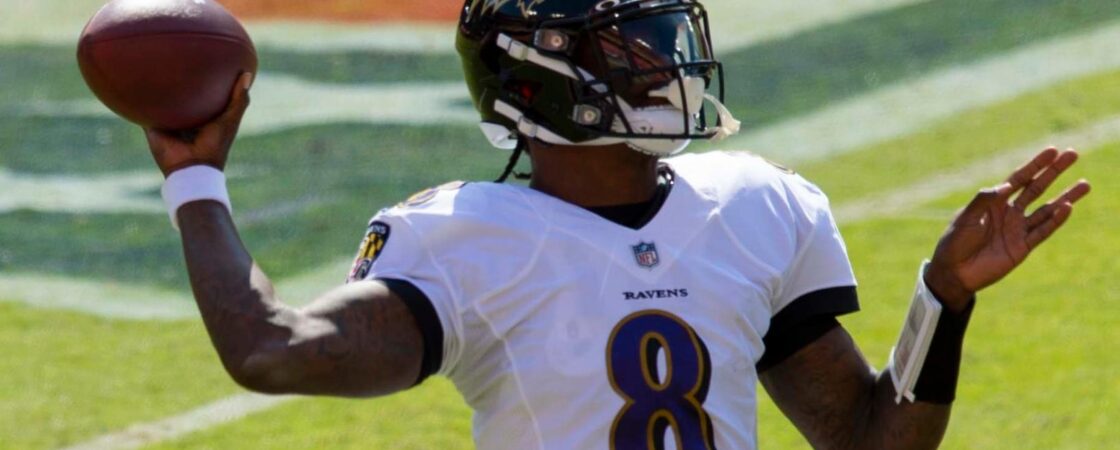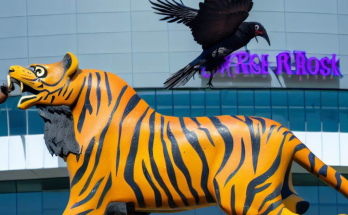The Baltimore Ravens took two wide receivers with their first five picks in the 2021 NFL Draft. They took Minnesota wide receiver Rashod Bateman in the first round, and followed that up with Oklahoma State wide receiver Tylan Wallace in the fourth round. The Baltimore Ravens’ brass then went around telling anyone that would listen about their plans to throw the ball more in 2021. They will undoubtedly throw the ball more than they did in the last two seasons, where they ranked dead last in both 2019 and 2020, throwing the ball an average of just 26.4 times per game. To give you an idea of how far back in the ranks that sits, the Tennessee Titans threw the ball 29 times per game over the last two years, and they ranked second.
So, the Baltimore Ravens are set to pull their passing game up by its bootstraps, and it’s time for fantasy football to reap all the rewards. After all, the 2020 Buffalo Bills went from one of the least pass-happy teams to one of the most pass-happy teams, just by adding Stefon Diggs! Right? Well, no. The 2019 Buffalo Bills passed the ball 513 times, which ranked #24 overall until they added Stefon Diggs and 83 pass attempts to vault up to eleventh in the league. But, they weren’t in the complete doldrums like the 2019 and 2020 Baltimore Ravens. In fact, if the Ravens add exactly as many passes to their 2020 pass total as the Bills added to their 2019 total, then the Ravens still only have 489 pass attempts, which would have been in the bottom ten in pass attempts every year since 2002.
The Pass Attempt Deficit
Before we explore what a stepped-forward Baltimore Ravens passing game would look like, I have to stress to you in deep detail just exactly how far behind the rest of the league they sit. The Baltimore Ravens passed the ball 157 times fewer than the average NFL team last year, which puts them at the biggest deficit since the NFL realigned divisions in 2002. Only three teams have finished with a deficit over 150: the 2004 Pittsburgh Steelers, the 2012 Seattle Seahawks, and the 2020 Baltimore Ravens. The 2005 Steelers repeated as the team’s bargain-basement pass attempting offense, and the Seahawks got all the way up to #31 in 2013 before returning to the basement. There’s a very good reason for this: teams can’t change their DNA overnight, and they definitely can’t do it by adding a first-round wide receiver and really, really wanting to change!
Since the league went to 32 teams, four teams went from the basement in pass attempts to the top-half of attempts; all four changed their week one starting quarterback the year following their basement drop. While Ben Roethlisberger played the vast majority of 2005, Tommy Maddox started the year as their starter. They ranked dead last in pass attempts before vaulting up to #14. The 2006 Atlanta Falcons swapped out Michael Vick for Joey Harrington, and predictably ran less and passed more. The 2012 Broncos went from Tight End Tim Tebow to Peyton Manning in the biggest glow-up in a QB room in NFL history. Even they only ended up ranking tenth in pass attempts the following season. Finally, the 2016 Vikings went from Teddy Bridgewater to Sam Bradford and added about 132 pass attempts in the process (#12 in the NFL).
What if the Ravens Change Philosophies?
A central component of changing out from the basement to a top-half passing offense is not adding a wide receiver, it is adding a quarterback. The Ravens have the same QB and same offensive system as they did last year, they just have better wide receivers and a strong desire to pass more. So what? As you can see, a desire to pass more does not translate into passing enough for it to matter. But what if the Ravens do take a step forward in the passing game, what does that look like?
Again, I want to remind you that the Ravens ranked #32 in pass attempts in back-to-back seasons, one of two teams to do this since the league ended up with 32 teams. On average, the #32 team ends up adding about 59 pass attempts to their offense the following season, with two teams (2002 Houston Texans and 2019 Baltimore Ravens) passing the ball fewer times the year after they finished last in pass attempts. But, let’s give the Ravens the benefit of the doubt.
Let’s say the Baltimore Ravens match the greatest single-season pass attempt jump, percentage-wise, from a #32 team. The Pittsburgh Steelers increased their passing by 38% between 2005 and 2006. If you add that percentage jump to the Ravens’ 2020, you end up with 564 pass attempts (over 16 games, the seventeenth game really mucks this all up). That’s a lot!
But, you have to consider that you have to compare this pass increase to the rest of the league. The average pass attempts in 2020? 564 pass attempts.
The Baltimore Ravens need an all-time increase in pass attempts in order to just become league average in pass attempts.
What Boost Can the Ravens Get?
Realistically, a team cannot change its DNA and philosophy in one offseason, at least not without changing out the quarterback. We talked about the biggest changes that coincided with QB changes, but what about teams that just really wanted to pass the ball more, what about them?
If you control for the teams who saw a massive boost from quarterback change, the average year-over-year change from the #32 team was an increase of just 35 targets. Only two teams (2009-2010 New York Jets and 2018-2019 Seattle Seahawks) saw increases of more than 50 targets. Two teams decreased in targets. Clearly, the Seahawks are the target here, as they increased by 90 targets between 2018 and 2019. I have to stress to you, this isn’t enough. This puts the Ravens at just 496 pass attempts over 16 games, which moves them from #32 to #29 in pass attempts (just behind the 2020 New York Jets).
That is not enough to support the hype train coming for the Ravens’ passing game.
What’s Stopping Them?
Again, I need to reiterate. The Baltimore Ravens need to have an all-time increase in pass attempts in order to go from the worst team in the league to merely average. Adding a ton of targets, but not an all-time number of targets, merely makes them “severely below average” instead of “dead last.”
And as we saw earlier, the limiting factor to a team going from the bottom of the barrel to the top half is not adding wide receivers and changing philosophy; it is changing quarterbacks.
This is not a knock on Lamar Jackson. I have to stress this, and I feel like I cannot stress this enough. This comes down to gameplanning and roster building to Lamar Jackson’s strengths. We’ve seen what happens to a running quarterback when a team tries to turn them into a pocket passer. It’s why Colin Kaepernick fell apart. Also, how do you expect to turn your offense over to passing with a running back room with 66 combined targets in 86 career games? How exactly does that work?
But, what if the Ravens go ahead and just open the flood gates and commit to passing more? Well, the league-leading touchdown rate certainly drops, as does the league-average interception rate. Granted, I doubt the yards per attempt changes, but I feel like that should be addressed here, as well: it’s about league average.
What Does a Lamar Jackson Passing Line Look Like?
To get the projected touchdown pass rate for Lamar Jackson should the Ravens get to league-average pass attempts, I took the five-highest touchdown rates of teams that passed more than 1,000 times over the last two years. This gives Lamar Jackson’s eliteness the benefit of the doubt while controlling for other low pass attempt offenses. This list gave us five undoubtedly elite QBs to work with: Aaron Rodgers, Tom Brady, Patrick Mahomes, Russell Wilson and Drew Brees. Truly, the cream of the crop here. This ends with Lamar Jackson having a 6.2% touchdown rate.
So, should Lamar Jackson and the Baltimore Ravens have an all-time increase in passing attempts while maintaining an elite touchdown rate, that gives the Baltimore Ravens 2.1 passing touchdowns per game. Let’s also assume his skill growth offsets his pass attempt growth, and he doesn’t regress in yards per attempt and interceptions. That gives him a weekly passing game line of: 2.1 touchdowns, 248.5 passing yards, and 0.8 interceptions per game.
Where Does This Put the Ravens?
248/2/1 sounds… fine, except when you consider that outside of yardage, this does not grow the Baltimore Ravens’ offense in any appreciable way. They currently average two touchdowns per game over the last two years, and the main growth, again, comes in the form of yardage. The Ravens currently pass for about 186 yards per game with Lamar Jackson, and bumping that up to 248 seems like a ton… but it would still be outside the top-ten.
So, Where Does This Leave Us?
The Baltimore Ravens sit at an all-time pass attempt deficit when compared to the rest of the league. Should they make an unprecedented all-time leap by changing philosophy and WR corps on the fly, they could end up with a league-average amount of pass attempts. Should Lamar Jackson remain in elite touchdown rate percentage, their only net gain comes in the form of yardage… an extra 62 yards per game.
Does that seem like enough to support increases from Marquise Brown, Rashod Bateman, Sammy Watkins and Mark Andrews? Let alone, Tylan Wallace, who is set to be a part of that increase in pass attempts? No. It’s because it isn’t. Hopefully, the Baltimore Ravens focus on the big three there (Brown/Bateman/Andrews) and eschew the flotsam and jetsam of that roster, which includes Watkins and Wallace (sorry to the Tylan Wallace heads out there). The Ravens offense will pass more, but even if they do, they still won’t pass enough to get us all hot under the collar.
The Ravens will pass more, but you shouldn’t pass… on clicking these links!
[Image Source: https://upload.wikimedia.org/wikipedia/commons/8/84/Lamar_Jackson_passing_2020_%28cropped%29.jpg, cropped under CC BY SA 2.0]





0 Comments on “The Baltimore Ravens Will Pass More, So What?”